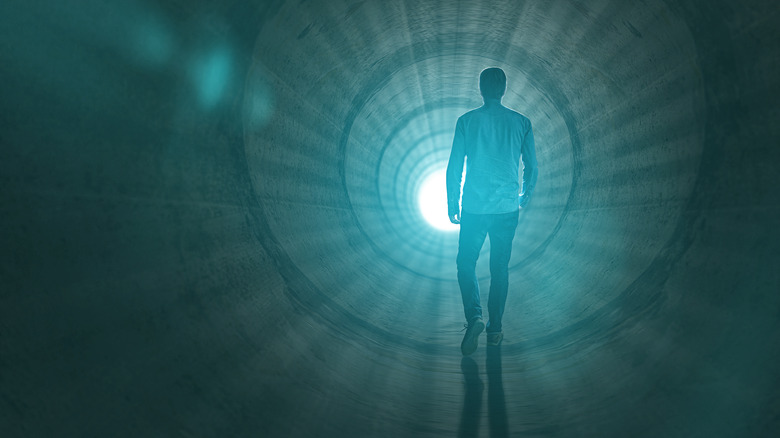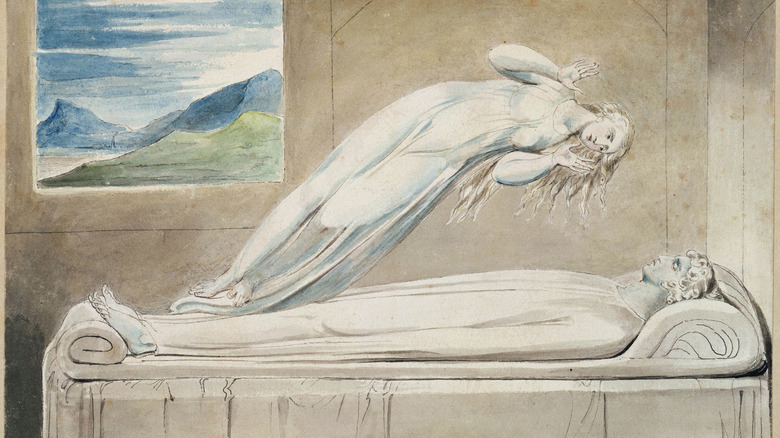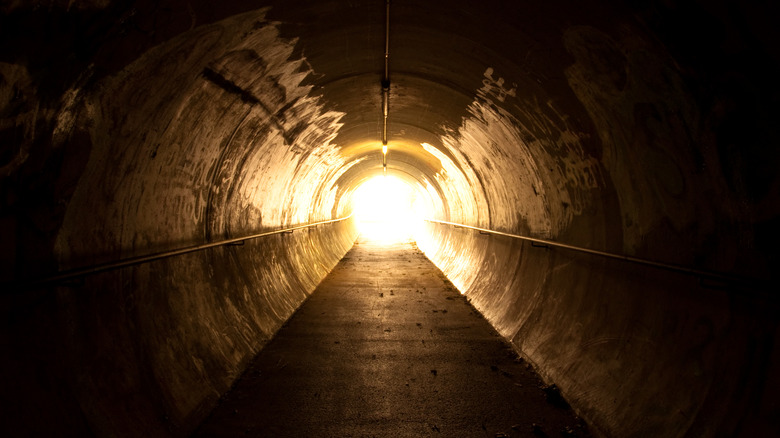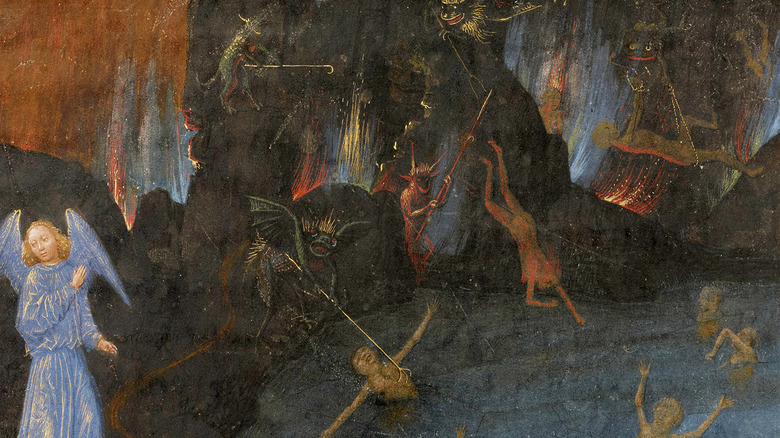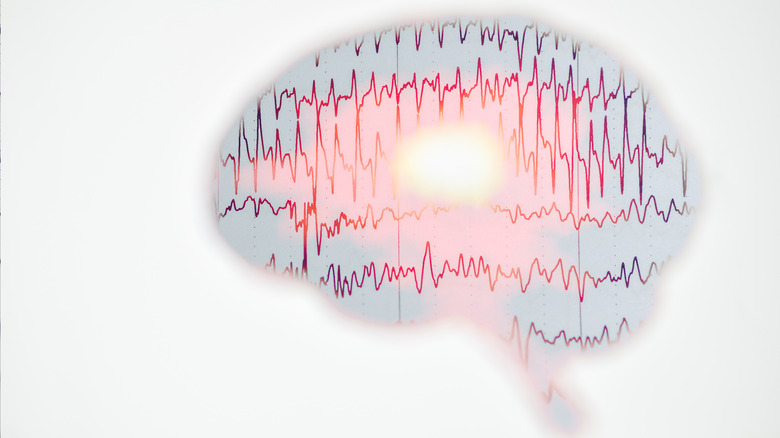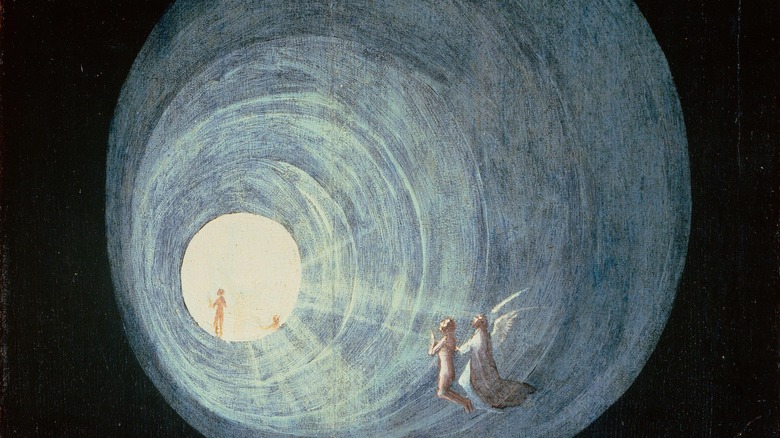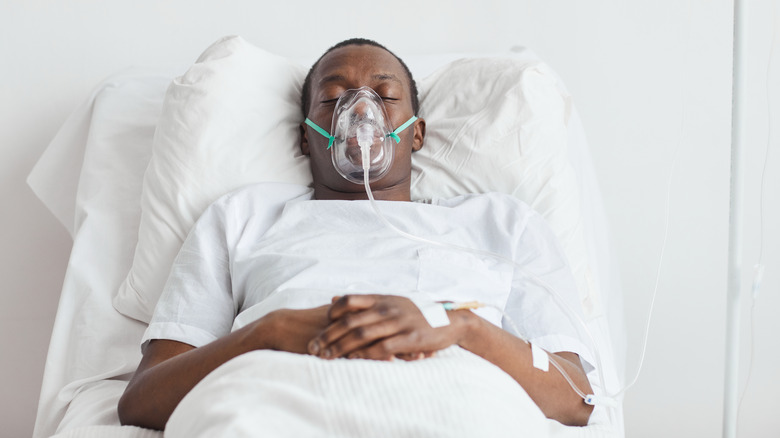What Happens During A Near-Death Experience
When a person goes through a close encounter with death, be it through a medical emergency, an accident, or some other means, they may come back with nothing to report. They simply experience missing time, with no recollection of what happened while they were incapacitated. Yet, others may come back to consciousness with unexpected tales of encountering bright lights, dead relatives, and mysterious landscapes populated by inhuman beings. Near-death experiences like these have become fascinating, and sometimes controversial, topics for laypeople and scientific researchers alike.
According to The Guardian, the term "near-death experience" was coined in 1975 by psychiatrist Raymond Moody in the book "Life After Life." But this sort of event, often shortened to "NDE," has been reported by people for centuries. As the journal Resuscitation reports, the earliest known medical report of an NDE comes to us from the 1740s, though it's possible that earlier, more mystical accounts might fit the bill if only modern researchers had more information.
Today, NDEs are linked to a few critical details, some of which are so common that they've become cliches in the world of near-death tales. The University of Virginia School of Medicine's Division of Perceptual Studies notes that these experiences typically include features like euphoria, traveling through a tunnel, bright lights, enhanced perception, and a replay of one's life, among other key elements. Though many other aspects of this phenomenon remain mysterious, here's what may be going on during a near-death experience.
Near death experiences may feel hyper real
The University of Virginia School of Medicine notes that a common characteristic of many reported NDEs is the sense that one's mind is both working faster and processing information more clearly than while awake. One man, Gregg Nome, said that his brush with death while stuck beneath a waterfall included a flood of memories that he was nevertheless able to perceive in fine detail. As he told an NDE support group organized by researcher Dr. Bruce Greyson (via The Guardian), he was so aware that he could pick out the minutiae of his environment even while he was mid-drowning.
A 2013 study published in PLoS One indicated that NDE patients could recall their experiences with greater detail compared to both real and imagined memories of the non-dying sort. The experiences were also more emotional and focused on the self, perhaps contributing to the intensity of their recollections. However, that may also mean someone keeps going over the experience in their mind and may inadvertently embellish it over time.
The study's authors concluded that, while NDEs may not be strictly "real" in the same way that other memories are linked to real-world events, they're certainly processed in a very similar way. These events are also distinct from hallucinations or everyday memories. Whether or not a patient literally floated unseen above their body or spoke to a dead relative, they're likely to perceive it as an extra-real and often deeply felt experience.
Replays of life events are common
To say that your life flashed before your eyes may sound cliche, but people who have had an NDE can tell you that this really happens (per the University of Virginia).
One very unique study offers insight into the life review phenomena with real scientific data. Published in 2022 in Frontiers in Aging Neuroscience, it centers on a very small sample of just one 87-year-old man. After developing epileptic seizures, the unnamed patient was put under continuous electroencephalography (EEG) monitoring to gather more data. In the midst of the recording, the man suffered a heart attack and died. This allowed scientists to observe the electrical activity in a dying human brain for the first time ever. Given that the patient died, this isn't technically a near-death experience, but the 900 seconds of brain activity that were recorded offer valuable insight into what NDE experiencers may be going through.
Essentially, researchers saw changes in brain waves immediately before and after the man's heart attack. The specific brain waves, referred to as brain oscillations in the study, were linked to functions that included memory, dreaming, perception, and information processing. Of course, there are some key limitations of this study. Researchers weren't able to interview the patient after his death, after all, and the findings would be more definitive if more dying patients' brain waves were recorded via EEG machines. Yet it hints that this common aspect of NDEs may have an explanation rooted in biology.
People report leaving their body
Another common feature of many NDEs is an "out-of-body experience" in which people report leaving their body and sometimes floating above it, as per the University of Virginia School of Medicine. Out-of-body experiences can also happen to people who aren't dying. Stressful events like childbirth (via Journal of Midwifery & Women's Health) or medical conditions such as epilepsy (via Frontiers in Human Neuroscience) may push otherwise healthy people to feel as if they've left their physical bodies.
A 2022 review in Resuscitation Plus indicated that patients who received CPR during cardiac arrests reported that they remained aware on some level, though it's unclear if they are genuinely recalling what happened during their resuscitation. A study from the NYU Grossman School of Medicine also suggests that unconscious patients may still be producing brain waves and processing information in a way that includes a belief that they've left their body and can observe what's happening.
Sometimes these out-of-body experiences are said to produce the most compelling evidence for NDEs. One commonly retold story is that of "Maria," who experienced cardiac arrest in 1977 in Seattle. She later told medical staff about a shoe on a ledge, giving minute details about the cast-off footgear. When someone went to check, they found the shoe. What's more, it was reportedly in such a position that the only way Maria would have been able to examine it was if she was floating (via The Atlantic).
Many see tunnels and lights
Speaking to NPR, Randy Schiefer said that his March 2020 encounter with COVID-19 nearly killed him. Though his month-long medically-induced coma left him seemingly unable to perceive anything around him, when Schiefer woke, he said otherwise. Among other details, he recalled moving through a tunnel dotted with beams of light, then entering a room filled with more of the light, which left him feeling loved and euphoric.
The very first account of such an experience, published in the first half of the 18th century, mentions a patient's encounter with an intense light that he associated with heaven. The man's doctor, Pierre-Jean du Monchaux, blamed it on increased blood flow to the brain, while modern researchers suggest that this intense, oftentimes calming light could be linked to altered states of consciousness similar to REM sleep (via Discover).
Some describe a journey through a dark tunnel with a light at the end. As per a 2015 article published in the Journal of Near-Death Studies, some researchers have linked this to a patient's fading, narrowing vision. Yet, there may be a cultural element to this striking image, at least in the western hemisphere. In India, near-death experiencers don't always encounter tunnels and light (via the Journal of Near-Death Studies). If human biology were at the root of all these tunnels and lights, then researchers would expect to see similar reports regardless of culture or individual.
Some are oddly calm
On first impression, you would think that an NDE would be utterly terrifying. You are dipping your toe into the reality of your own death, after all. Yet many who have gone through an NDE have reported feeling calm or even downright comforted. Sir Francis Beaufort, a British admiral who survived a close call with drowning in 1791, later wrote that he was both free of pain and fear during his experience (via Scientific American). Indeed, it's one of the more common characteristics of this experience as outlined by a 2020 study in PLoS One.
What exactly is going on here? Spiritually-minded people might turn to explanations that hinge on the existence of an all-loving deity, for instance. For those seeking out a more strictly logical explanation, brain chemistry might hold the key to these chilled-out encounters with mortality. A 2011 study published in Neuroscience Letters noted that dying rats in a lab environment showed dramatic increases in serotonin, a chemical that acts as a neurotransmitter and also can induce euphoria and feelings of well-being (via Harvard Medical School).
A small number of near-death experiences are negative
As a 2020 PLoS One study notes, the majority of near-death experiences are positive. But a small portion of NDEs can be nothing short of terrifying.
According to Missouri Medicine, there are three broad categories of negative NDEs: "inverse, void, and hellish." Inverse NDEs can have many of the same experiences as positive ones, but the individual finds them stressful. In void NDEs, an experiencer encounters an endless and terrifying void. Finally, hellish NDEs effectively send someone to hell or at least an environment that they interpret as such. These might involve moving downward, witnessing others in pain, or being attacked by inhuman creatures. After recovery, some patients take this as a sign to change their lives, while others struggle with the implications of their NDE for years.
A handful of NDEs may contain both positive and negative elements. Randy Schiefer told NPR that his experience included a tunnel full of calming light and a stunning "golden city." Yet Schiefer panicked when he felt that he could not return. A 1988 case study published in the Journal of Near-Death Studies related the story of Vera, who was in a bad car accident in 1981. During her NDE, she encountered a tunnel, lights, and hyperreal greenery. She also entered a church-like building and came face to face with a figure she identified as the devil, who poured fire out of a goblet and caused her to scream and run away.
NDE experiencers could be in a unique state of consciousness
As researchers have dug deeper into the question of what exactly is going on in the brain during an NDE, it's become clear that something strange is going on in the consciousness. As Dr. Kevin Nelson writes in Missouri Medicine, there appears to be a link between the kind of awareness that is part of an NDE and something practically everyone goes through every night — the stage of sleep characterized by rapid eye movement (REM). Specifically, Nelson points to the blending of waking and REM sleep, which can produce hallucinations, lucid dreaming, and sleep paralysis. He notes that NDE patients appear to be especially prone to this blending of awake and REM states.
Brain activity during an NDE may be similar to another class of consciousness-altering events: seizures. A 2014 study in Frontiers in Human Neuroscience found that about 7% of participants who dealt with epileptic seizures reported an out-of-body experience similar to what someone might feel during an NDE (though the authors caution that this isn't a smoking gun linking the seizures and out-of-body experiences).
Some report encountering relatives
If some peoples' reports are anything to go by, the afterlife is already fairly populated. That's because some experiencers say that, at some point in their NDE, they encountered relatives or other people who had predeceased them. As per the journal Death Studies, people may report seeing these already dead people or otherwise sensing them through their voices or even an impression of their presence nearby.
The phenomenon is also common among dying patients, who may report seeing relatives who have gone before them as they're nearing their own end. Dr. Christopher Kerr, a hospice doctor, has become one of the most prominent researchers of this phenomenon. Speaking to Discover magazine, he argues for the validity of these patients' experiences, of which he's collected more than 1,400 individual accounts. He's not ready to call these visions proof of an afterlife, but they are clearly a profound spiritual experience for many people at the end of their lives. Like in NDEs, these encounters with dead relatives can be deeply affirming and comforting, lessening patients' fears of death.
Other experiencers report meeting nonhuman entities
NDE experiences might cross paths with familiar faces like those of dead relatives or passed-on friends, but they may also encounter more mysterious beings. According to Dr. Bruce Greyson, writing in "The Science of Near-Death Experiences," it's common for people to report meeting with noncorporeal presences that are sometimes also linked to light. Depending on an individual's perception of the event and their cultural context, they may turn to religion to make sense of these nonhuman bits of intelligence.
A case study published in 2000 in the Journal of Near-Death Studies outlined one such experience. The woman in question had a close call with drowning in 1981. After losing consciousness, she had classic NDE features such as feeling calm, being hyper-aware, witnessing a life replay, and encountering light at the end of a tunnel. In the light, she encountered a maternal woman who told her that it was time to go back to the world of the living. More than a decade later, while helping her daughter recover from an accident, she encountered the same being, which she believed to be angelic.
These beings need not be based on Western cultures or Christian theology, either. Indian NDE experiencers sometimes report encounters with "messengers" of the Hindu god of death, as per a 1986 study published in The Journal of Nervous and Mental Disease.
Low oxygen might be the cause of NDEs, but only sometimes
While a few theories that seek to explain NDEs center on electrical activity and neurochemicals, another zeroes in on a lack of oxygen. Otherwise known as anoxia (a complete lack of oxygen circulating in the body) or hypoxia (when your oxygen levels are too low to keep vital systems going), this oxygen deficit is a common component of medical emergencies. If a heart stops beating, then it can't supply oxygen-rich blood to the vital organs that so desperately need it, like the brain. And if the brain is losing out on oxygen, then all manner of strange things can happen in there.
For instance, a lack of oxygen can have a dramatic effect on vision. According to Frontiers in Neuroscience, these symptoms can include tunnel vision, euphoria, and the loss of both light and color in one's visual field. Dr. Susan Blackmore has suggested that hypoxia and anoxia could be responsible for NDE features like the appearance of a tunnel with a light at its end (via Journal of the Royal Society of Medicine).
Dr. Bruce Greyson offers a counterpoint in his chapter "The Science of Near-Death Experiences," noting that not all NDEs are associated with oxygen-depleting medical emergencies. In fact, some studies have shown that oxygen levels aren't all that different during an NDE compared to other patients. Moreover, another symptom of hypoxia is anxiety and agitation, hardly in line with the groovy, chilled-out vibe of many NDEs.
Some report that near death experiences can be shared
Throughout much of the literature on death, dying, and near-death experiences, people who go through these events do so alone. But do they? In a small but very striking number of cases, near-death experiences may be shared with the living in what feels like a very real way.
Though people have been reporting shared death experiences for centuries, the concept came to wider attention after psychiatrist Raymond Moody, who coined the term "near-death experience," began discussing the shared death phenomenon in the early 2000s. As he told CNN, shared death experiences may be even more puzzling than classic NDEs, as you can't blame medical emergencies like car accidents or heart attacks on the still very alive co-experiencer. One hospice volunteer told CNN that, while reading to a dying and unresponsive patient, he suddenly found himself floating with the patient, looking down at their bodies. Military personnel who are next to dead or dying comrades may have a similar experience, such as one World War I soldier who felt himself float upwards and start down a tunnel with his friend, who had just been killed by an artillery strike. Perhaps the stress and heightened emotion of the shared situation, whether it's a sudden death on a battlefield or a slower exit in a hospice, can induce these experiences in otherwise healthy people. Others say this is an indication of something more spiritual going on.
Experiencers can make dramatic changes to their lives afterward
Perhaps one of the most profound things that can happen during an NDE is something that is hard to pin down in a single event or symptom. During the experience, a person may be so deeply affected that they are a new person afterward, one who may have even become unrecognizable to those who knew them before. As Dr. Bruce Greyson told The Guardian, many NDE experiencers lose their fear of the moment of death. After having gone through the process of dying, mortality simply loses its bite. As a result, they may also be more inclined to live in the present moment and take more chances earthside. Some may lose the taste for their old careers and lives and become someone else entirely, perhaps becoming service-oriented figures in the community like nurses and social workers.
There are negative aftereffects to be felt, as well. Writing in Missouri Medicine, Greyson says that NDEs can seriously shake up someone's preconceptions about the afterlife and may lead some to wonder if they're just going crazy. Family and friends might also recoil from this person, who has returned very changed after their brush with death, leading to long-term problems with isolation and depression. Their mental health may also take a turn, as patients are more likely to disassociate from the world around them and even go through posttraumatic stress disorder.
